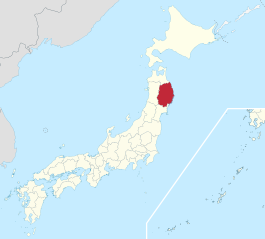Iwate Prefecture
Iwate Prefecture
Nham tay huyện | |
|---|---|
 Iwate PrefectureinJapan | |
| Country | |
| Capital | Iwate |
| Subdivisions | List
|
| Government | |
| •Governor | Takuya Tasso |
| Area | |
| • Total | 15,275 km2(5,898 sq mi) |
| Population (October 1, 2020) | |
| • Total | 1,210,534 |
| • Density | 79.25/km2(205.3/sq mi) |
| Time zone | UTC+09:00 |
| Area code | 03000-7 |
| ISO 3166 code | JP-03 |
| Website | Official website |
Iwate Prefecture(Nham tay huyện,Iwate-ken)is aprefecturein theTōhoku regionofJapan.It is on the island ofHonshu.[1]Thecapital cityisMorioka.[2]
History[change|change source]
The area of Iwate was part ofMutsu Province.[3]
In 1869, Mutsu was split into five new provinces:Rikuōku,[4]Rikuchū,[4]Rikuzen,[4]Iwashiro[1]andIwaki.[5]The first three of these together known as the "Three Riku", orSanriku.[6]
The new provinces were abolished in July 1871.[7]
In theMeiji period,the provinces of Japan were converted into prefectures. Maps of Japan and Mutsu Province were changed in the 1870s.[3]
Geography[change|change source]
Iwate is the second largest prefecture afterHokkaido.[1]
The prefecture is in theTōhoku regionof Honshū island. It has the island's easternmost point.[8]The eastern coastline faces thePacific Ocean.Iwate shares its northern border withAomori Prefecture.The western border meetsAkita Prefecture.Its southern border is shared withMiyagi Prefecture.
Cities[change|change source]
National Parks[change|change source]
National parks cover about 5% of the total land area of the prefecture.[9]They include:
Shrines and temples[change|change source]
Tsutsukowake jinjais the mainShinto shrine(ichinomiya) of the prefecture.[12]
The Buddhist temples ofHiraizumiincludeChūson-jiandMōtsū-ji.Hiraizumi was added to theWorld Heritage Listin June 2011.[13]
Related pages[change|change source]
- Provinces of Japan
- Prefectures of Japan
- List of regions of Japan
- List of islands of Japan
- Iwate Museum of Art
References[change|change source]
- ↑1.01.11.2Nussbaum, Louis-Frédéric (2002).Japan Encyclopedia.Harvard University Press. p. 410.ISBN978-0-674-01753-5.
- ↑Nussbaum, Louis-Frédéric (2002).Japan Encyclopedia.Harvard University Press. p. 661.ISBN978-0-674-01753-5.
- ↑3.03.1Nussbaum, Louis-Frédéric (2002).Japan Encyclopedia.Harvard University Press. p. 780.ISBN978-0-674-01753-5.
- ↑4.04.14.2Nussbaum, Louis-Frédéric (2002).Japan Encyclopedia.Harvard University Press. p. 790.ISBN978-0-674-01753-5.
- ↑Nussbaum, Louis-Frédéric (2002).Japan Encyclopedia.Harvard University Press. p. 408.ISBN978-0-674-01753-5.
- ↑Nippon-Kichi,"Saw-tooth Sanriku Coastline".Retrieved 2012-1-12.
- ↑Japan-i,Sanriku Coastline/Kamaishi DaikannonArchived2011-07-22 at theWayback Machine.Retrieved 2012-1-12.
- ↑Nussbaum, Louis-Frédéric (2002).Japan Encyclopedia.Harvard University Press. p. 970.ISBN978-0-674-01753-5.
- ↑Japan Ministry of the Environment,"General overview of area figures for Natural Parks by prefecture".Retrieved 2012-3-13.
- ↑Japan Ministry of the Environment,"Towada-Hachimantai National Park"Archived2006-05-16 at theWayback Machine.Retrieved 2012-3-19.
- ↑Japan Ministry of the Environment,"Rikuchu Kaigan National Park"Archived2006-05-16 at theWayback Machine.Retrieved 2012-3-19.
- ↑"Nationwide List ofIchinomiya,"p. 2Archived2013-05-17 at theWayback Machine.Retrieved 2012-1-17.
- ↑"World Heritage Hiraizumi".Retrieved2013-07-10.



